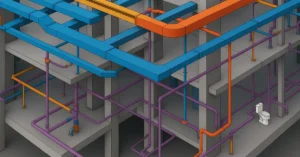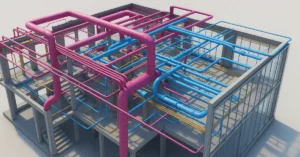Crafting Tomorrow’s Workspace: Architectural Trends

In the fast-paced world of business, the workplace is not merely a physical space; it’s a dynamic ecosystem that shapes organizational culture, productivity, and employee well-being. As we venture into 2024, the landscape of workplace design is undergoing a profound transformation driven by a confluence of technological advancements, environmental consciousness, and evolving work patterns. In this article, we delve deep into the architectural trends that are redefining the future of workspaces, ushering in an era of sustainability, innovation, and human-centric design.
Carbon-Negative Design:
One of the most compelling architectural movements gaining momentum in 2024 is the adoption of carbon-negative design principles. In response to the escalating climate crisis, architects and designers are pioneering solutions aimed at not just minimizing carbon emissions but actively sequestering carbon from the atmosphere.
By leveraging innovative construction techniques and materials such as carbon-capturing concrete and sustainable timber, buildings can serve as carbon sinks, offsetting their environmental footprint. The ethos of carbon-negative design aligns seamlessly with the global imperative to combat climate change, making it a cornerstone of sustainable architecture in the years to come.
Restorative Soundscapes:
In an era characterized by constant connectivity and sensory overload, the importance of creating tranquil and rejuvenating work environments cannot be overstated. Restorative soundscapes represent a paradigm shift in workplace design, harnessing the therapeutic power of sound to enhance employee well-being and productivity.
From immersive nature sounds to curated playlists featuring ambient music and binaural beats, architects are integrating soundscaping techniques to create calming auditory environments that promote focus, reduce stress, and foster creativity. By prioritizing acoustic comfort alongside visual aesthetics, workplaces are evolving into havens of tranquility where employees can thrive amidst the cacophony of modern life.
Hybrid Workspaces:
The COVID-19 pandemic accelerated the transition towards remote work, fundamentally reshaping the traditional office landscape. In 2024, the concept of hybrid workspaces has emerged as a defining trend, catering to the diverse needs of in-office and remote employees alike. These flexible environments seamlessly blend physical and virtual elements, offering collaborative zones, hot-desking areas, and state-of-the-art video conferencing facilities.
By embracing a hybrid model, organizations can harness the benefits of remote work while preserving the social cohesion and creative synergy that thrive in shared physical spaces. The hybrid workspace represents a paradigm shift in how we conceptualize the office, emphasizing adaptability, inclusivity, and work-life balance in the digital age.
Biophilic Design:
In an age of urbanization and technological immersion, the innate human connection to nature often takes a backseat in the built environment. Biophilic design seeks to remedy this disconnect by reintroducing elements of nature into architectural spaces, thereby enhancing human health, happiness, and productivity.
From living green walls and natural light to organic shapes and textures, biophilic design principles evoke the restorative power of the outdoors, fostering a sense of calm and connection in indoor settings. By incorporating biophilic elements into workplaces, architects are not only revitalizing the sensory experience of occupants but also promoting environmental stewardship and ecological awareness.
Smart Tech:
The proliferation of smart technology has revolutionized every aspect of modern life, and the workplace is no exception. In 2024, smart tech integration is reshaping the built environment, transforming static buildings into responsive and adaptive ecosystems. From intelligent lighting and climate control systems to IoT-enabled occupancy sensors and predictive maintenance algorithms, smart buildings optimize energy efficiency, streamline operations, and enhance occupant comfort.
By harnessing the power of data analytics and machine learning, organizations can gain valuable insights into occupancy patterns, space utilization, and environmental performance, empowering them to make informed decisions that drive productivity and sustainability.
Modular Furniture:
Flexibility and adaptability have become hallmarks of contemporary workplace design, reflecting the evolving nature of work and collaboration. Modular furniture solutions offer a versatile and scalable approach to space planning, allowing organizations to reconfigure layouts on-demand to accommodate changing needs and preferences.
From movable partitions and modular workstations to collapsible meeting pods and transformable lounge areas, modular furniture systems empower employees to personalize their workspace, fostering a sense of ownership and empowerment. By embracing a modular approach, organizations can optimize spatial efficiency, promote agile workflows, and cultivate a culture of innovation and creativity.
Sustainability:
In an era defined by environmental consciousness and corporate social responsibility, sustainability has emerged as a non-negotiable imperative in workplace design. From material selection and construction practices to energy consumption and waste management, architects are embracing a holistic approach to sustainability that prioritizes resource efficiency, carbon neutrality, and circularity.
By integrating renewable energy sources, implementing passive design strategies, and embracing the principles of the circular economy, workplaces can minimize their ecological footprint while maximizing their positive impact on the planet. Sustainable architecture not only mitigates environmental harm but also enhances the health and well-being of occupants, fostering a symbiotic relationship between humans and the built environment.
Conclusion:
As we navigate the complexities of the 21st-century workplace, architecture stands at the forefront of innovation, shaping environments that inspire, empower, and endure. The architectural trends outlined in this article represent a glimpse into the future of workplace design, where sustainability, technology, and human-centric principles converge to create spaces that are not only functional and efficient but also inspiring and transformative.
By embracing these trends, organizations can unlock the full potential of their workforce, driving innovation, collaboration, and growth in the ever-evolving landscape of work. As we embark on this journey towards a more sustainable and human-centered future, let us reimagine the workplace as a beacon of possibility, where architecture becomes a catalyst for positive change in society and the world at large.
If you’re interested in learning more about architecture firms in Europe, check out this comprehensive list of the top 50 firms compiled by Archgyan. From innovative startups to long-established industry leaders, this list has it all. Take a look and discover some of the most inspiring and influential architecture firms in Europe today.
If you’re interested in architecture and want to learn more about this amazing field, subscribe to our podcast on youtube
For more SketchUp tutorials, head to https://www.sketchupguru.com










